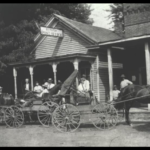

During World War I, in the summer of 1918, the Army leased 20,000 acres of property in the area of Stithton, Ky., a small farming community in Hardin County desired for its close proximity to the railroad and higher elevation. Under Major W. H. Radcliffe, constructing quartermaster at Camp Knox, construction of buildings began in August 1918.
The land at Stithton was soon acquisitioned by the Army and more land was acquired from Bullitt and Meade counties. The new post was named Camp Henry Knox in honor of General Henry Knox, Chief of Artillery in the Revolutionary War and first Secretary of War.

That same year, Camp Knox’s Godman Field was built for the 29th Aero Squadron, becoming the first airfield in Kentucky.
The Army’s force was reduced in the early 1920s and the post closed as a permanent installation in 1922, though Camp Knox remained an active training center for the Army.
MECHANIZED CAVALRY HEADQUARTERED
In 1931, Camp Knox was chosen to be the new headquarters for the Mechanized Cavalry as the size and terrain made it suitable for such training. On Jan. 1, 1932, Camp Knox was made a permanent installation and from then on has been known as Fort Knox. Two weeks later, the 1st Cavalry Regiment, the Army’s oldest mounted unit, arrived at Fort Knox and exchanged horses for armored combat cars.
In 1937, Fort Knox was called upon to guard gold moving into the Treasury Department’s new depository.

ARMORED FORCE HEADQUARTERED AT FORT KNOX FOR WW II
In the summer of 1940, with the outbreak of World War II in Europe, the American Army created the Armored Force and headquartered it at Fort Knox. It was responsible for establishing armored formations, doctrine and training in the use of armored vehicles.
In October 1940, the Armored Force School and Armored Force Replacement Center were established, training soldiers in specific areas such as armor tactics, tank gunnery, communications and maintenance.

During World War II, armor made great advancements through the development of new tanks, organization and training. In 1943, the Armored Force was re-designated as the Armored Command, and within a year was changed to the Armored Center. In 1957, it became the US Army Armor Center.
The Cold War helped secure the Armor Branch’s role in the Army and the Armor Center continued to fulfill the role of producing capable and highly trained armor personnel. By the late 1960s, more than one million trainees had completed one or more training programs in the Fort Knox Training Center since its inception in 1940.
During the Gulf War in the early 1990s, Fort Knox served as a mobilization center and provided combat-ready Soldiers.
2005 BRAC CHANGES MISSIONS AT FORT KNOX
With the 2005 Base Realignment and Closure (BRAC) Commission, the Armor Center and School relocated to Fort Benning to merge with the Infantry Center and form the Maneuver Center of Excellence.

“Home of Cavalry and Armor” for seven decades, Fort Knox embraced several new missions brought about by the BRAC transformations.

Army Human Resources Command, Army Accessions Command and Cadet Command relocated to Fort Knox, joining Recruiting Command and making the installation the center for the Army’s human capital management.
Additional units relocating to Fort Knox included the 3rd Brigade Combat Team, 1st Infantry Division; Army Reserve Readiness Training Center; 100th Division Headquarters; and the 3rd Sustainment Command (Expeditionary).
Not long after the BRAC moves were completed, Army Accessions Command and the 3rd Brigade Combat Team, 1st Infantry Division were inactivated.
In 2014, the Army consolidated all ROTC Cadet Summer Training at Fort Knox, bringing upwards of 10,000 trainees to the installation each summer. Most recently, the 3rd Sustainment Command (Expeditionary) moved to Fort Bragg, N.C., while the 1st Sustainment Command (Theater) relocated to Fort Knox.